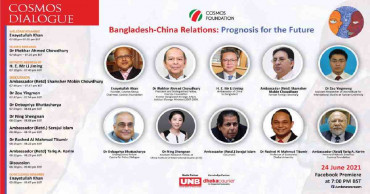Enayetullah Khan
Enayetullah Khan joins AsiaNet board meeting in Singapore
AsiaNet’s annual board meeting and forum is taking place in Singapore, bringing together delegates from across the region to discuss the evolving role of press releases in the AI era.
The two-day event, running 25–26 September, carries the theme ‘Press releases, the new AI superpower’.
Delegates arrived on 24 September ahead of a packed agenda featuring board discussions, knowledge-sharing sessions and networking.
UNB Editor-in-Chief Enayetullah Khan and Executive Editor Nahar Khan also joined the event.
“This gathering will empower Asia’s media and PR sectors through innovation, strategic growth and collaboration as it has brought together key stakeholders, including leaders from national news agencies and technology experts,” Enayetullah Khan said.
Enayetullah Khan to represent Bangladesh at Global South Media and Think Tank Forum in China
Thursday’s board meeting reviewed FY25 financial results, PR volumes, platform updates, and new Notified circuits, along with international partner updates from Accesswire, Agility PR and Notified.
The forum opened with a keynote by Amrita Sidhu on press releases’ influence on AI models, followed by Karen Yu of Notified GlobeNewswire presenting platform developments.
Agencies, including Xinhua, VNA, Dataxet, Kyodo, Medianet, United News of Bangladesh (UNB) and Antara, showcased how they use AI in PR.
Nahar Khan, UNB Executive Editor made a presentation on AI in media, and how to ensure content is optimized for AI discoverability and referencing.
Though cautious and aware of AI’s hallucinations and bias amplification, she focused on UNB’s aspirations to explore agentic, predictive, and decision-support AI tools and systems to stay ahead of the curve in newsroom innovation and to better serve evolving audience needs.
Friday’s programme includes a fireside chat with Jin Ooi, an AI showcase of the Media Release Optimiser by Katrina Sammut, and a panel moderated by Amrita Sidhu with representatives from Dataxet, Antara, Notified GlobeNewswire and UNB.
The forum will close with scheduling discussions for 2026 board meetings. AsiaNet continues to prioritise collaboration and innovation, exploring AI’s potential to enhance the global impact of press releases.
3 months ago
AsiaNet Board Meeting & Forum urges embracing innovation
The AsiaNet Board Meeting & Forum was held in Singapore on January 22-23, emphasising the need for digital transformation, industry learning and embracing technological advancements.
The high-profile Forum brought together prominent media leaders to discuss innovation, collaboration, and the future of media and PR in the region, with representatives from AsiaNet partners Xinhua, VNA, Yonhap, Dataxet, Bernama, Kyodo, Medianet, UNB and PTI in attendance.
Among the key participants were Enayetullah Khan, Editor-in-Chief of United News of Bangladesh (UNB), and Nahar Khan, Executive Editor of UNB, who actively contributed to the discussions during the event.
Two-day fact-checking training begins at UNB
AsiaNet's forum focused on operational and strategic growth while delving deeper into the theme of "Embracing Innovation."
A key highlight was a panel session moderated by Amrita Sidhu from Medianet. The panellists included Nahar Khan (Executive Editor, UNB), Pannee Yongpiyakul (Managing Director, Dataxet), Anubha Verma (CMO, PTI), and Michiko Fujimoto (Director, Kyodo JBN).
Nahar Khan emphasised how UNB leverages technology to optimize news distribution, enhance audience engagement, and improve efficiency while adhering to its core values of trust and information integrity.
UNB Editor-in-Chief Enayetullah Khan invited to World Media Summit
Darren Thayre, Director of Innovation and AI Partnership Lead, Global Strategic Initiatives at Google, delivered an engaging keynote on leveraging AI for strategic initiatives, further inspiring attendees to embrace forward-thinking solutions in the media and PR industry.
11 months ago
Debapriya calls for protection of a national eco-data system
Dr Debapriya Bhattacharya, Distinguished Fellow of the Centre for Policy Dialogue (CPD), on Thursday described national data as the "Fifth Pillar of the State" and called for the protection of a national eco-data system.
"If we want to drive development of Bangladesh towards advancement, the existing lack of data, if this lacking cannot be mitigated, then the planning will not be right resulting in the non-up to the mark implementation,” he said.
Dr Debapriya made the remarks while delivering the keynote speech at the Distinguished Lecture Series: “The State of Bangladesh Economy: What Is To Be Done?” at a city hotel.
The Bay of Bengal Institute and Cosmos Foundation jointly organised the event.
Read: Roundtable discusses data integrity for development
Cosmos Foundation Chairman and Bay of Bengal Institute Chairman Enayetullah Khan delivered the welcome speech, while Cosmos Foundation President Dr Iftekhar Ahmed Chowdhury chaired the programme.
Ambassador (Retd) Tariq Ahmad Karim, Honorary Emeritus Adviser to Cosmos Foundation and President of the Bay of Bengal Institute, delivered the closing remarks.
Debapriya, also the head of the white paper committee, said the Bangladesh Bureau of Statistics has to be established on a modern and scientific base.
“And it should be given protection, for that National Statistics should be seen as the fifth pillar of the state. And like the Election Commission and Public Service Commission it should be turned into a commission,” the eminent economist said.
August floods: Curtain rises on ‘Art for Aid: Rebuilding Lives’ at Gallery Cosmos
1 year ago
Bangladesh number one place to engage 3 big powers and play a bridging role: Prof Kanti Bajpai
Despite some difficulties, Bangladesh is the number one place to engage all three big powers – India, China and the United States - in a bridging role, says a Singapore-based foreign affairs analyst.
“Anything to do with China and India has a shadow over the United States as well. And so I think Bangladesh is the number one place to engage all three in a bridging role,” said Professor Kanti Prasad Bajpai, Vice Dean, Lee Kuan Yew School, National University of Singapore.
He was speaking at a discussion this week as part of Cosmos Dialogue Distinguished Speaker’s Series, entitled “China-India Relations: Implication for South Asia.”
“I think its (Bangladesh’s) diplomatic links with both China and India, probably the strongest amongst all the countries of South Asia. The kind of positive equidistance that Bangladesh has between China and India probably no other country in this region can match. It also has fairly good relations with the United States,” Prof Bajpai said.
Read More: China "unswervingly mediating" between Bangladesh, Myanmar to promote Rohingya repatriation: Ambassador Yao
The discussion was chaired and conducted by President of Cosmos Foundation and renowned scholar-diplomat and former Advisor on Foreign Affairs of Bangladesh Caretaker Government Dr Iftekhar Ahmed Chowdhury.
2 years ago
First-ever Ocean Collective Summit held in Singapore
The International SeaKeepers Society organised the first-ever edition of The Ocean Collective Summit (TOCS) at ONE° 15 Marina Sentosa Cove in Singapore recently. TOCS is part of Blue Water EduFest 2022 and the inaugural event saw Guest of Honour Mr Desmond Lee, Minister for National Development and Minister-in-Charge of Social Services Integration in attendance. He later delivered a speech reiterating the nation's commitment to coastal conservation as part of Singapore's sustainability endeavours.
While weather patterns of late give a grim indication of the impact of climate change, the resounding message from the Conference was one of hope, encouragement and more importantly, one of personal responsibility. Speakers ranging from keynote speaker; famed Aquanaut, Oceanographic Explorer and Environmental Advocate, Fabien Cousteau; Dr Karenne Tun, Director of the Coastal and Marine and Terrestrial Branches, National Biodiversity Centre, National Parks Board (NParks); and Dr Steven Fong, Programme Chair DMAC, Republic Polytechnic; stressed the importance of personal action. Enayetullah Khan, conservationist and founder of WildTeam, attended the summit on the first day, November 3.
Instead of waiting for work or action to be taken by the authorities or a collective group, individual action is just as important and should not be neglected, the conference conveyed. Speakers also urged attendees to look at making changes in their daily habits, a change of mindset, and even changing the language. For instance, instead of "seafood", the term can be replaced with "sealife" so that in time, sea creatures are seen as cohabitants of the planet and not just food for consumption. Dr Tun further shared the personal actions she's taking with her lifestyle as a demonstration of how everyone has a part to play to help achieve the targets set out in The Singapore Green Plan 2030.
Read more: UNCLOS can be a pathway to ocean of opportunity for LDCs: Bangladesh
The message of personal responsibility rings true for today's youth who formed a large part of the audience. The youth are identified as the group showing the most concern as well as the group most demanding for action to be taken. The message of personal responsibility and action resonated with the attendees and set the stage for the second day of the conference.
The second day of the conference (Nov. 4) also explored how corporate citizens maintain the balance between commercial requirements and responsibility to the environment. Speakers from some of the world's most established brands, such as Citi Private Bank, SDAX, Archwey and VE Capital and Company, shared how their organisations provide solutions towards achieving sustainability.
About The Ocean Collective Summit
The Ocean Collective Summit (TOCS) is a programme initiated by The SeaKeepers in cooperation with Fabien Cousteau; the Founder of The Fabien Cousteau Ocean Learning Centre and Proteus Ocean Group; and famed for his work as an Aquanaut, Oceanographic Explorer and Environmental Advocate.
TOCS aims to bring a focus on the ocean and its intricate connections to life and all the inhabitants of our planet, Earth. Through its annual conference, TOCS will gather thought leaders to educate, raise awareness and inspire action to be taken and work collectively towards a more sustainable future.
The International SeaKeepers Society
The International SeaKeepers Society was founded in 1998 by a small group of yacht owners who were alarmed by the deterioration of our natural environment. The organisation's initial focus was on the development and use of instrumentation on yachts to monitor marine conditions throughout the world's oceans. Today, The International SeaKeepers Society continues to work with yachts as a vital part of its programming.
The International SeaKeepers Society strives to increase current knowledge about the oceans, promote and facilitate scientific discovery and raise awareness about critical ocean issues. The International SeaKeepers Society works directly with the yachting community as an essential component and contributor to ocean research and conservation efforts. The organisation runs several yacht-involved programs to accomplish this mission.
Read more: UN Ocean Conf: Bangladesh reaffirms commitment to achieve SDG-14
The International SeaKeepers Society began expansion into Asia in 2016 with the SeaKeepers Asia chapter. Building upon established international programming, the focus in Asia is creating awareness of the current situation of our oceans in Asia in order to build a sense of appreciation and commitment to protect, conserve and restore when possible.
3 years ago
Cosmos dialogue on Bangladesh-South Korea relations to be premiered Thursday
The latest edition of Cosmos Foundation-hosted Ambassadors’ Lecture Series titled "Bangladesh-South Korea Relations: Prognosis for the Future" will be premiered on Thursday.
South Korean Ambassador to Bangladesh Lee Jang-keun will deliver the keynote speech at the dialogue that will be premiered on the Facebook pages of Cosmos Foundation and UNB and its YouTube channel.
Enayetullah Khan, Chairman of the Cosmos Foundation, will deliver the inaugural remarks.
Read: Cosmos Dialogue on Dhaka-Washington ties premieres Saturday on Facebook
Dr Iftekhar Ahmed Chowdhury, a Singapore-based renowned scholar-diplomat and former Foreign Affairs Advisor of Bangladesh Caretaker Government, will chair and conduct the session.
Dr Debapriya Bhattacharya of the Centre for Policy Dialogue, Chairman and CEO of Youngone Corporation and KEPZ Corporation (BD) Ltd Kihak Sung, former BGMEA President and Mohammadi Group Chairperson Dr Rubana Huq, former Bangladesh Ambassador to South Korea Iftikharul Karim; and Research Fellow and Head at Bangladesh Centre for Terrorism Research (BCTR) Shafqat Munir will comprise the panel of discussants.
Ambassador Lee will share his plans on further strengthening the relations between the two countries as the Golden Jubilee of diplomatic relations between the two countries in 2023 is seen as an opportunity for the two countries to diversify the areas of cooperation.
Read: Australian envoy sees potentials for future bilateral cooperation “golden”
Since the establishment of diplomatic ties between the Republic of Korea and Bangladesh in 1973, the two countries have been enhancing cooperation in various fields, such as politics, economy, culture, development cooperation and human exchange.
Additionally, more than 150 Korean companies are there in Bangladesh, making the Republic of Korea the largest investor in Bangladesh's garment sector.
Their investments in recent years have been diversified into infrastructure, energy and consumer goods.
4 years ago
Ambassador Ito sees 5 challenges ahead to elevate Dhaka-Tokyo ties
Japanese Ambassador to Bangladesh Naoki Ito has identified five challenges ahead that Bangladesh and Japan need to address together to elevate the solid partnership to a higher level with multifaceted greater cooperation as the two countries are set to celebrate 50 years of diplomatic relations in a big way next year.
The five challenges, he said, are: to develop Bangladesh-Japan strategic partnership, make Bangladesh more attractive for business, expand people-to-people exchange, enhance cooperation with Bangladesh as a partner to realize Free and Open Indo-Pacific and strengthen efforts to increase Bangladesh’s stature in the region and beyond.
“We need to move forward. I think our relations will naturally deepen in each of those agendas but we shouldn’t take it for granted,” Ambassador Ito said while delivering the keynote speech at a virtual dialogue that premiered on Sunday evening.
Cosmos Foundation, the philanthropic arm of the Cosmos Group, hosted the dialogue titled “Bangladesh-Japan Relations: Prognosis for the Future” as a part of its ongoing Ambassador’s Lecture Series.
The opening remarks were delivered by the Cosmos Foundation Chairman Enayetullah Khan. The session was chaired by Dr Iftekhar Ahmed Chowdhury, renowned scholar-diplomat and former Advisor on Foreign Affairs of Bangladesh Caretaker Government.
Md Abul Kalam Azad, Special Envoy, Climate Vulnerable Forum; Hayakawa Yuho, Chief Representative, JICA Bangladesh Office; Dr Salehuddin Ahmed, former Governor, Bangladesh Bank; Prof Masaaki Ohashi, Professor, University of the Sacred Heart, Tokyo; Manzurul Huq, columnist, writer and academic; Prof Takahara Akio, Dean, Graduate School of Public Policy, the University of Tokyo and Ambassador (Retd) Tariq A Karim, Honorary Advisor Emeritus, Cosmos Foundation comprised the panel of discussants.
Ambassador Ito said the two countries should make “conscious and constant efforts” to continue to enjoy the current state of relationship and develop it even further. “We shouldn’t be complacent about ourselves.”
He said the year 2022 will provide an excellent opportunity to elevate the partnership even to a higher level and wished that the two countries could call the partnership as “truly strategic partners”.
Ambassador Ito who already spent 20 months in Bangladesh said the development of quality infrastructures and the strengthening of connectivity under the Bay of Bengal Industrial Growth (BIG-B Initiative) will be beneficial not only to the development of Bangladesh but also to regional peace and stability.
“Our leaders are really conscious that this BIG-B is important - not only for the development of Bangladesh but also for the stability of the entire Bay of Bengal region, beyond Bangladesh itself,” he said.
Enayetullah Khan said even as Japan’s geo-strategic role and position grows in great strides, Japan has remained faithful in its commitments to Bangladesh that significantly contributed to Bangladesh’s current emergence as a development success story.
“To me, it seems Bangladesh-Japan friendship is a function of not just mutual benefits, but mainly of pure fellow-feeling. From whichever perspective you view Bangladesh-Japan friendship, it’ll stand out in all weathers and seasons as does in 36 views of Mount Fuji in the famous paintings of HOKUSAI,” he said.
4 years ago
Japan to grab any opportunity to resolve Rohingya crisis for regional stability
Japanese Ambassador to Bangladesh Naoki Ito has said Japan will seize the opportunity to find a “long-term and lasting solution” to the Rohingya crisis with the Myanmar side, noting that the issue is very relevant to the future stability of the entire region.
“What we can say right now is Japan will seize the opportunity to raise this very, very important issue with the Myanmar side and its military now whenever appropriate,” he said.
The Japanese envoy said his country will do its best to create an enabling environment for the early repatriation of Rohingyas and will continue to raise the issue with the Myanmar side whenever appropriate.
He was responding to a question at a virtual dialogue titled “Bangladesh-Japan Relations: Prognosis for the Future” where he delivered the keynote speech.
Cosmos Foundation, the philanthropic arm of the Cosmos Group, hosted the dialogue as a part of its ongoing Ambassador’s Lecture Series.
The opening remarks were delivered by the Cosmos Foundation Chairman Enayetullah Khan. The session was chaired by Dr Iftekhar Ahmed Chowdhury, renowned scholar-diplomat and former Advisor on Foreign Affairs of Bangladesh Caretaker Government.
Md Abul Kalam Azad, Special Envoy, Climate Vulnerable Forum; Hayakawa Yuho, Chief Representative, JICA Bangladesh Office; Dr Salehuddin Ahmed, former Governor, Bangladesh Bank; Prof Masaaki Ohashi, Professor, University of the Sacred Heart, Tokyo; Manzurul Huq, Columnist, writer and academic; Prof Takahara Akio, Dean, Graduate School of Public Policy, the University of Tokyo and Ambassador (retd) Tariq A Karim, Honorary Advisor Emeritus, Cosmos Foundation comprised the panel of discussants.
Also read: Ambassador Ito sees 5 challenges ahead to elevate Dhaka-Tokyo ties
Ambassador Ito said humanitarian assistance and humanitarian crises are very much part of their vision when they talk about stability and peace of the region.
He said it is very difficult to predict what is going to happen in Myanmar right now in light of the current situation in that country since the February 1 military coup with a complete standoff.
4 years ago
Symposium on Bangladesh-China relations to be premiered Thursday
An online symposium on Bangladesh-China Relations: Prognosis for the Future, hosted by Cosmos Foundation, will be premiered on its Facebook page at 7pm on June 24.
The keynote address at the symposium was delivered by Chinese Ambassador to Bangladesh Li Jiming which was recorded on Saturday.
Read:Cosmos Dialogue on Dhaka-Washington ties premieres Saturday on Facebook
Experts both from Bangladesh and China were brought together to assess the state of relations between Bangladesh and China and identify the challenges and opportunities that lie ahead in the efforts to take it forward.
Cosmos Foundation Chairman Enayetullah Khan delivered the opening and closing remarks at the event.
Renowned scholar-diplomat and adviser on foreign affairs to the last caretaker government Dr Iftekhar Ahmed Chowdhury chaired the session.
Read:‘The Black Story’ exhibition by Gallery Cosmos launched virtually
Ambassador (retd) Tariq A. Karim, CPD Distinguished Fellow Dr. Debapriya Bhattacharya, former Foreign Secretary Shamsher M Chowdhury, Assistant Researcher of the Institute for International Studies at Yunnan University Dr Zou Yingmeng, Assistant Research Fellow at China Institute of International Studies Dr Ning Shengnan, former Ambassador Serajul Islam and Dhaka University Professor Dr Rashed Al Mahmud Titumir joined it as the panel of discussants drawn from both sides.
The full video of the event will be available for viewing on the Facebook page of the Cosmos Foundation, and (elsewhere) from Thursday at any time, following the premiere.
In Cosmos Foundation’s Ambassador Lecture Series, the envoys of various countries stationed in Dhaka are invited to deliver a keynote, before engaging with a high-level expert panel on bilateral ties between Bangladesh and the country they represent.
Read:US Ambassador Miller visits art exhibition on PM at Cosmos Centre
Cosmos Foundation, the philanthropic arm of conglomerate the Cosmos Group, brings together the finest minds to arrive at a prognosis for the future of the relationship, in line with its commitment to eliciting strategic insights and policy solutions for Bangladesh as it charts its course toward a future that is ever brighter.
4 years ago
Enayetullah Khan joins NU Singapore’s NIC as Distinguished Council Member
Enayetullah Khan, Editor-in-Chief of United News of Bangladesh and Dhaka Courier, and founder of Cosmos Group, has joined the National University of Singapore’s Medicine International Council (NIC) as a Distinguished Council Member.
Kishore Mahbubani, Chairman of the NUS Medicine International Council, has extended the invitation to Enayetullah Khan.
Read:Enayetullah Khan represents Bangladesh at 17th OANA General Assembly
The NIC is an exclusive network of international leaders, academics, and experts who not only help address the greatest challenges in healthcare, public health policy, population studies, and ground-breaking research in cancer, diabetes, and other chronic diseases but also identify promising opportunities and innovations across multi-disciplinary areas, including information technology, engineering, computing, social sciences, and medicine.
In his letter to Enayetullah Khan, Mahbubani said, “We are delighted that you have accepted our invitation to join the NUS Medicine International Council. Given your long and distinguished career, I have no doubt that you will make a significant contribution to the work of the Council. I share your confidence that by pooling our efforts together, we can bring health and happiness to the global community.”
Read:Afsan Chowdhury joins UNB, Dhaka Courier as Editor-at-Large
Mahbubani also mentioned, “If there is one big lesson that we should learn from Covid-19, it is that public policy makes a huge difference in the field of medicine. Why did 500,000 people die in the US (a rate of 1,543 per million)? Why did far fewer people (a rate of 5 per million), die in New Zealand, also a western democracy? The answers are complex but one clear difference was that the quality of public policies implemented by New Zealand in response to Covid-19 were superior.”
Extending his gratitude to Khan for joining the NIC, he added, “Our recent experiences with Covid-19 have sent us a clear message: good public policies in medicine save lives. Hence, I hope that when this professorship is established, it will also result in research that will save even more lives in the future.”
Read:Veteran journalist Farid Hossain joins UNB as Advisory Editor
NIC members are recognised for their service and scope of generosity to medical research and development and are actively engaged as the NUS Medical School’s ambassadors to the wider world. This distinguished group of men and women includes leaders in government, business, finance, pharmaceuticals, healthcare, law, and other fields from around the world.
4 years ago







.jpg)








